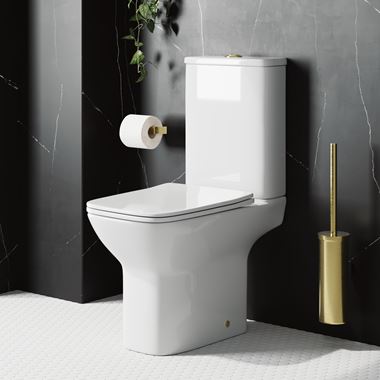The evolution of toilets is a testament to the progress of human civilization, where even the most mundane aspects of life undergo transformative changes. From primitive chamber pots to sophisticated, water-saving models, the toilet has evolved significantly over the centuries. A contemporary trend gaining momentum is the adoption of rimless toilet designs. In this comprehensive exploration, we will traverse the historical roots of toilets, analyze the conventional models, and delve into the innovative realm of rimless designs.
The Early Days of Toilets: A Historical Overview:
The journey of toilets can be traced back to ancient civilizations, where various cultures developed rudimentary forms of waste disposal. From ancient Rome’s communal latrines to the chamber pots used in medieval Europe, the toilet has evolved alongside societal advancements.
The Industrial Revolution marked a turning point with the introduction of flush toilets, setting the stage for further innovations.
The Conventional Toilet Design: Pros and Cons:
Conventional toilets, with their familiar bowl and rim structure, have been the standard for many decades. While these toilets have served their purpose, they come with challenges. The rim, a crucial component, often becomes a breeding ground for bacteria and germs, leading to hygiene concerns.
Additionally, cleaning these intricate structures can be cumbersome, prompting the need for a more efficient and hygienic alternative.
Introduction to Rimless Toilets:
Rimless toilets represent a paradigm shift in toilet design by eliminating the traditional rim around the bowl. This revolutionary approach not only addresses hygiene concerns but also simplifies the cleaning process.
The absence of the rim ensures that there are no hidden nooks for bacteria to thrive, contributing to a more sanitary and visually appealing bathroom experience.
Hygiene Matters: The Rimless Advantage:
One of the primary drivers behind the increasing preference for rimless toilets is the emphasis on improved hygiene. The rimless design minimizes the risk of bacterial buildup, providing a cleaner and more hygienic environment in the bathroom.
This aspect is particularly crucial in today’s health-conscious society, where cleanliness is paramount.
Water Efficiency: A Sustainable Choice:
In an era of environmental awareness, rimless toilets align with the global push for sustainability. Many rimless designs incorporate water-saving technologies, ensuring efficient flushing while reducing water consumption.
This not only benefits the environment but also contributes to cost savings for homeowners in the long run.
Ease of Cleaning and Maintenance: A Game-Changer:
Cleaning a traditional toilet, especially in hard-to-reach areas, can be a laborious task. Rimless toilets simplify this process, making it easier for homeowners to maintain a clean and sanitary bathroom.
The streamlined design eliminates hidden crevices, ensuring that cleaning efforts are more effective and less time-consuming.
Aesthetics and Modern Bathroom Trends:
Beyond functionality, the aesthetics of a bathroom play a crucial role in modern home design. Rimless toilets offer a sleek and contemporary look that aligns with current bathroom trends.
The absence of the rim contributes to a minimalist and visually appealing design, making rimless toilets a preferred choice for homeowners seeking both style and functionality.
FAQs:
Q1: Are rimless toilets difficult to install?
A1: No, rimless toilets are typically installed in a manner similar to traditional toilets, and many models come with user-friendly installation guides.
Q2: Are rimless toilets durable?
A2: Yes, rimless toilets are designed for durability and often come with warranties. Regular maintenance ensures a longer lifespan.
Q3: Do rimless toilets require special cleaning products?
A3: While no specific products are required, using non-abrasive, toilet-friendly cleaners is recommended to maintain the toilet’s finish.
Q4: Are rimless toilets suitable for all bathroom sizes?
A4: Yes, rimless toilets come in various sizes and designs, making them adaptable to different bathroom layouts.
Q5: Can rimless toilets handle waste effectively?
A5: Yes, rimless toilets are designed for efficient waste removal, and their flushing mechanisms are engineered to maintain cleanliness.
Q6: Are rimless toilets more expensive than conventional ones?
A6: While prices may vary, the initial cost of rimless toilets is often comparable to that of high-quality conventional models.
Q7: Can rimless toilets be retrofitted in existing bathrooms?
A7: In many cases, rimless toilets can be retrofitted into existing bathrooms with minimal modifications.
9. The Future of Toilets: Technological Innovations and Beyond:
As technology continues to advance, the toilet is likely to undergo further innovations. Smart toilets with integrated bidet functions, touchless flushing mechanisms, and enhanced water-saving features are anticipated to shape the future of bathroom fixtures.
Conclusion:
In conclusion, the evolution of toilets showcases a journey marked by innovation, addressing hygiene concerns, and embracing sustainability. Rimless toilet designs represent a contemporary solution that combines functionality with aesthetics, offering a cleaner, more efficient, and visually pleasing option for modern homeowners. As the world continues to prioritize health, sustainability, and design, rimless toilets are poised to become an integral part of the ongoing evolution of this essential household fixture.

A group of home improvement enthusiasts and bathroom design experts, combines in-depth knowledge and a shared passion to deliver engaging, informative content that guides readers through the world of bathroom innovation and style.

Leave a Reply